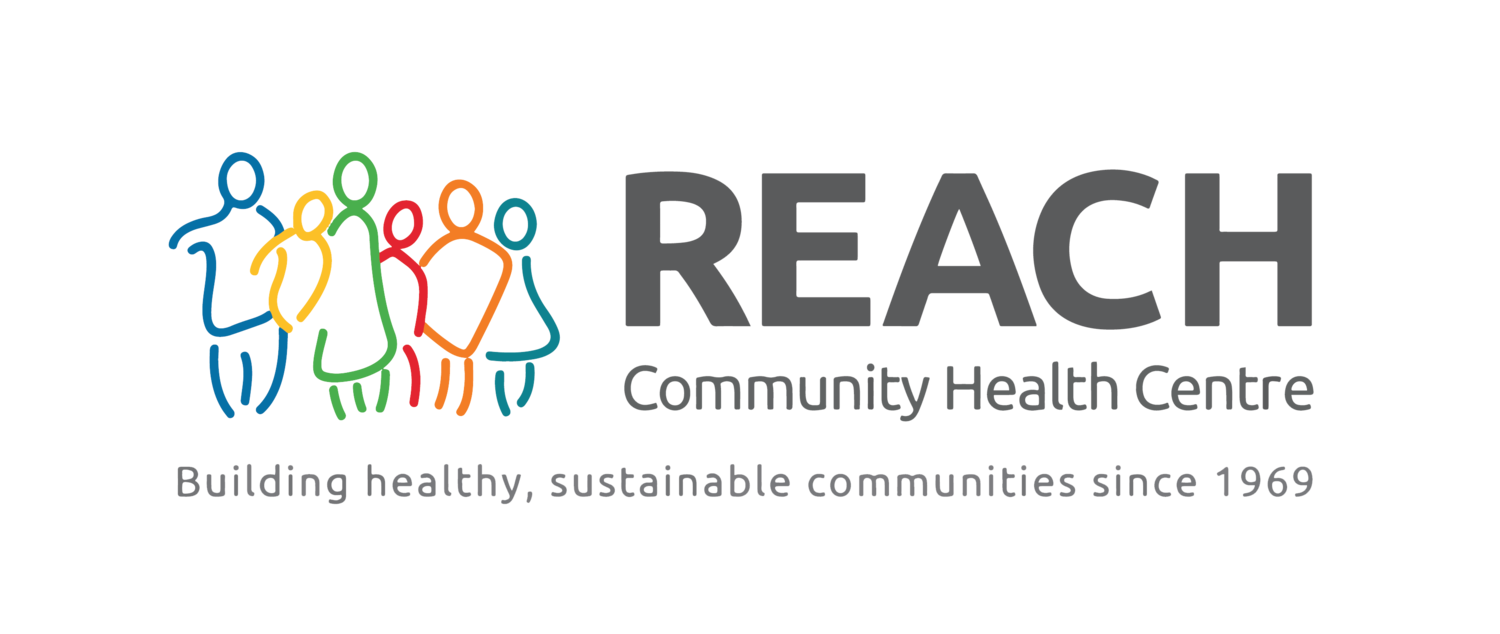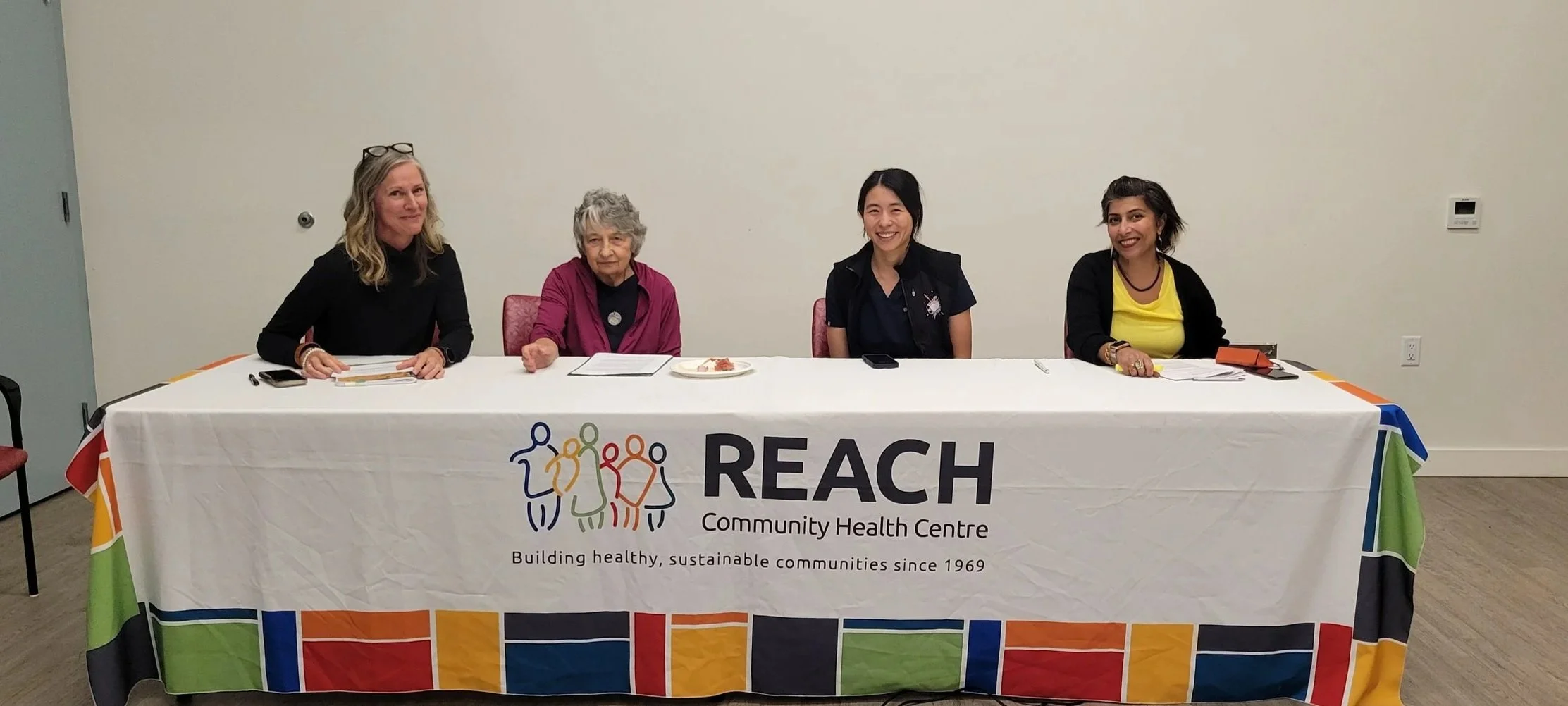Community Panel
Topic: ‘Care in Community - The Role of Community Health Centres in Public Healthcare’
This timely discussion focused on the role of Community Health Centres (CHCs) in BC’s healthcare system, providing holistic, team-based care that addresses not only illness but also the broader social determinants of health. The panelists shared personal and professional experiences, highlighting both successes and systemic gaps, and explored opportunities for sustainable growth and policy influence.
From left to right: Melinda Markey, Marcy Cohen, Kelly Lau, Daisy Kler
Moderator:
Melinda Markey – Executive Director, REACH Community Health Centre
Panelists:
Marcy Cohen – Board Director & Research Associate, BC Society for Policy Solutions
Daisy Kler – Manager, Multicultural Family Centre, REACH
Kelly Lau – Medical Director, REACH Urgent and Primary Care Centre (UPCC)
Question 1: What does community health look like in practice, not in theory, and how is it realized at REACH?
Kelly Lau (Family Doctor, Medical Director at REACH Urgent and Primary Care Centre):
Kelly outlined her experience with an elderly patient who had years of traumatic experiences, who finally felt safe accessing trauma-informed care through REACH. She emphasized that CHCs provide care for patients who face complex challenges such as trauma, mental health concerns, addictions, and chronic disease through coordinated interdisciplinary support.
Kelly highlighted, “I see CHCs as evidence-based and on-the-ground huge safety nets for these patients that would otherwise, because of the social determinants of health, find it difficult to be attached to a primary care clinic, seek the care they need, and essentially live a meaningful life.” She added the clinic’s flexibility in responding to community crises (e.g., COVID-related gaps in care) and reiterated that inter-disciplinary care allows CHCs to fill systemic gaps by connecting patients with housing support, cultural resources, social services, and specialty care.
Daisy Kler (Manager, REACH Multicultural Family Centre):
Daisy highlighted that CHCs implement tailored strategies, including prevention programs, culturally and linguistically appropriate services, health promotion, and community engagement. Examples include Vietnamese women’s programming with exercise and breast cancer screening initiatives that reach populations who are often mistrustful of mainstream health systems. She emphasized that CHCs not only address health inequities but also have the potential to shift the institutional structures that create them.
Daisy described CHCs as catalysts for social change, integrating activism and community advocacy into daily practice, and emphasized the importance of mobilizing collective power to influence policy and equity-focused reform. “The promise of CHCs, for me, is that we not only acknowledge and respond to health inequities, but they aim to dismantle the structures in the institutions that create the inequities.”
Question 2: What are the biggest gaps in the health system that CHCs are filling?
Marcy Cohen (Researcher and Advocate):
Marcy shared insights from other community health centres where specific CHC programming addressed multiple health concerns and adopted a multidisciplinary approach.
-Mid Main Community Health Centre (East Vancouver): The reintroduction of CHC funding restored nurse practitioner and pharmacist support, allowing patients with complex conditions to receive thorough, coordinated care.
-Umbrella Multicultural Health Co-op (New Westminster): Provides multilingual support, culturally tailored services, and health promotion programs. Many contributions, such as outreach, workshops, and education, often go unrecognized in traditional health system metrics.
-Victoria Cool Aid Society - Community Health Centre (Victoria): Serves people experiencing homelessness and substance use. Offers mobile outreach and integrated care, including mental health and housing support, filling a gap otherwise absent in the system.
Kelly Lau:
Kelly emphasized that CHCs play a vital role in addressing barriers faced by marginalized populations, including immigrants, refugees, temporary workers, and people with complex immigration status, who often have no access to care elsewhere. “One of the huge gaps REACH in particular has met over the past year is being one of the only sites that offers truly barrier-free care for these patients,” she shared. “We are providing life-saving compassionate care to people who simply don't have other options.” Her reflections underscored both the moral imperative and the practical importance of CHCs in filling systemic gaps within the healthcare system.
Daisy Kler:
Daisy noted that CHCs also address social and emotional gaps. Staff provide support for isolation, loneliness, and community engagement, which are often undervalued in health metrics but essential for improving health outcomes. CHCs create environments that foster social cohesion, belonging, and empowerment, especially for marginalized groups. “Without stable funding in the programs that foster belonging and social connection…we lose the capacity to facilitate that social connection, which is so important when we're thinking about community health centres.”
Question 3: What does the health system lose without stable CHC funding, beyond services themselves?
Daisy Kler:
"Trust is built over years…we lose that trust when we can’t keep up the services. We lose connection with those clients, and more importantly, the clients lose the connection to the other members in the group.” Daisy has seen firsthand how unstable funding erodes not only trust, but also the relationships, and social cohesion that CHCs work so hard to nurture. Without stable funding, CHCs risk losing their capacity to sustain social connection, uphold community values, and maintain culturally safe environments that are essential to holistic care.
Marcy Cohen:
Marcy highlighted Ontario’s approach to supporting CHCs as a strong example of success. The province’s longstanding commitment to stable funding, community governance, and integration within the broader health system has fostered a strong culture of care, deepened patient trust, and enhanced the influence of CHCs within the healthcare landscape. This demonstrates how sustained investment and systemic recognition strengthen the sector as a whole. “Stable funding strengthens CHCs’ capacity to shape a culture of care, not just deliver services.”
Audience Discussion:
Panelists expressed cautious optimism for BC, citing emerging opportunities through provincial consultations, CARGA related policy windows, and partnerships with equity-focused medical programs.
Independent fundraising can complement government funding, allowing CHCs to prioritize equity-driven initiatives without external constraints.
Volunteer-led initiatives can support programs temporarily to fill the gap, but core funding is essential for sustainability and autonomy.
Takeaway:
CHCs are more than healthcare providers. They are community anchors, safety nets, and catalysts for systemic change. Stable funding, team-based care, and community governance are essential for sustaining trust, addressing inequities, and shaping a culture of care that benefits the most marginalized populations.

